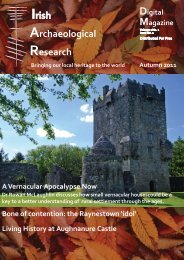Irish Archaeological Research Digital Magazine
Irish Archaeological Research Digital Magazine
Irish Archaeological Research Digital Magazine
Create successful ePaper yourself
Turn your PDF publications into a flip-book with our unique Google optimized e-Paper software.
Blight or Bliss?<br />
<strong>Irish</strong> <strong>Archaeological</strong> <strong>Research</strong> Issue 2 Jan 2012<br />
Ireland, small as it is, has one of the highest total lengths of highways‐per‐capita of any country in the world. This is<br />
due to the network of small roads which exist to serve the low‐density, distributed pattern of dwellings that<br />
characterise the landscape. This pattern is of ancient origin. Even in <strong>Irish</strong> prehistory, despite some<br />
recently‐discovered and notable exceptions, most dwelling houses have been discovered in isolation or in very small<br />
groups. Indeed, urban living, a phenomenon that has revolutionised societies for millennia, took an unusually long<br />
time to catch‐on in Ireland; it was a concept imported by Viking settlers. Even today, a very significant number of<br />
households are isolated dwellings in the countryside―according to census results this is the predominant se�lement<br />
type in most parts of the island.<br />
Figure 2: “Bungalow Blight” at The Rosses, Co. Donegal. (Image by Yakshini, licenced under Creative Commons BY‐NC‐SA 2.0)<br />
This distributed settlement pattern is at odds with some current thinking in rural planning, and has led to real<br />
problems in certain areas. The most visible difficulty with persisting with this tradition is the proliferation of<br />
“bungalow blight” in some places (e.g. Figure 2). Developers have been given free reign in some of the most scenic<br />
locations, and the resulting sprawl of houses is disastrous for both the environment and the landscape. However,<br />
much tension exists between various interest groups who promote such development on economic and social<br />
grounds and those who are more concerned with heritage or environmental issues, and wish development to be<br />
more rigorously controlled. The planning authorities seem caught between the two viewpoints, and definitive<br />
solutions have proved elusive. In Northern Ireland, rural planning has become a political “hot potato” in recent<br />
years; the strict regulations governing the buildings of one‐off dwellings have become electoral issues.<br />
The overall trend, however, is for an acknowledgement that indiscriminate building throughout the countryside<br />
causes social problems and pressure on infrastructure, and is to be discouraged in favour of more centralised<br />
development. It is seldom mentioned that centralised development has always been a marginal pattern in Ireland,<br />
especially compared to Britain and many European countries.<br />
32



